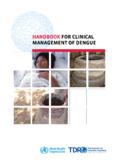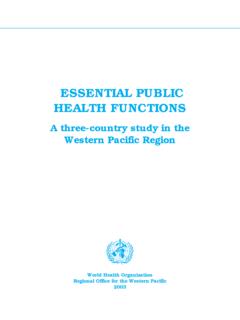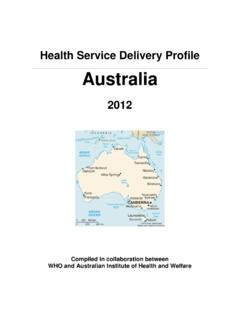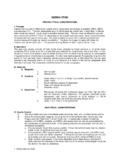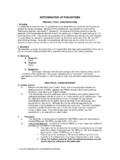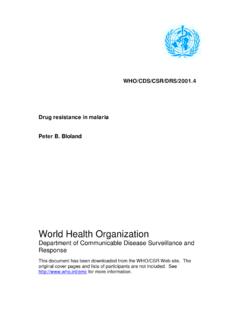Transcription of GIEMSA STAINING OF MALARIA BLOOD FILMS - WPRO
1 VERSION 1 EFFECTIVE DATE: 01/01/2016. GIEMSA STAINING OF MALARIA . BLOOD FILMS . MALARIA MICROSCOPY STANDARD OPERATING PROCEDURE MM-SOP-07A. 1. PURPOSE AND SCOPE. To describe the procedure for properly STAINING MALARIA BLOOD FILMS with GIEMSA stain. This procedure is to be modified only with the approval of the national coordinator for quality assurance of MALARIA microscopy. All procedures specified herein are mandatory for all MALARIA microscopists working in national reference laboratories, in hospital laboratories or in basic health laboratories in health facilities performing MALARIA microscopy. 2. BACKGROUND. A properly stained BLOOD film is critical for MALARIA diagnosis, especially for precise identification of MALARIA species.
2 Use of GIEMSA stain is the recommended and most reliable procedure for STAINING thick and thin BLOOD FILMS . GIEMSA solution is composed of eosin and methylene blue (azure). The eosin component stains the parasite nucleus red, while the methylene blue component stains the cytoplasm blue. The thin film is fixed with methanol. De-haemoglobinization of the thick film and STAINING take place at the same time. The ideal pH for demonstrating stippling of the parasites to allow proper species identification is Methods of STAINING The two methods for STAINING with GIEMSA stain are the rapid (10% stain working solution) and the slow (3% stain working solution) methods. The rapid (10% stain working solution) method This is the commonest method for STAINING 1 15 slides at a time.
3 It is used in outpatient clinics and busy laboratories where a quick diagnosis is essential for patient care. The method is efficient but requires more stain. The need for speed justifies the additional cost. The slow (3% stain working solution) method The slow method is used for STAINING larger numbers of slides ( 20). It is ideal for STAINING BLOOD FILMS collected during cross-sectional or epidemiological surveys and field research and for preparing batches of slides for teaching. It is less appropriate when a quick result is needed. The slow method is less expensive than the rapid method because it requires much less stain (3% rather than 10% stain solution). 3. SUPPLIES AND MATERIALS. For the rapid (10% stain working solution) method GIEMSA stain (10% solution) (See MM-SOP-04 for method of preparation).
4 A small container or beaker for GIEMSA working stain;. absolute methanol, acetone-free;. a Pasteur pipette with a rubber teat;. a small container or beaker for methanol;. a curved plastic STAINING tray, plate or STAINING rack;. a timer;. a slide-drying rack;. a small electric hair-dryer;. MM SOP 07A: GIEMSA STAINING OF MALARIA BLOOD FILMS . protective latex gloves, powder-free, disposable and Distilled or deionized water buffered to pH For the slow (3% stain working solution) method GIEMSA stain (3% solution) (See MM-SOP-04 for the method of preparation);. a small container for GIEMSA working stain;. absolute methanol, acetone-free;. a Pasteur pipette with a rubber teat;. a small container or beaker for methanol.
5 STAINING troughs that can hold 20 slides placed back to back;. a timer;. a slide-drying rack;. protective latex gloves, powder-free, disposable, and distilled or deionized water buffered to pH 4. SAFETY PRECAUTIONS. 1. Methanol (methyl alcohol) is inflammable and highly toxic if inhaled or swallowed; it can cause blindness and even death if swallowed in any quantity. Avoid contact and inhalation. When it is not in use, it should be stored in a locked cupboard. 2. Universal precautions including use of relevant personal protective equipment such as gloves, safety glasses and a laboratory coat or gown must be practised. See MM-SOP-11: General safety procedures in the MALARIA microscopy laboratory.
6 2. MM SOP 07A: GIEMSA STAINING OF MALARIA BLOOD FILMS . 5. PROCEDURE. FLOW CHART DESCRIPTION OF ACTIVITY. For the rapid (10%) method For the rapid (10%) method 1. Estimate the amount of 10% GIEMSA working solution 1. Prepare 10% GIEMSA working required for the number of slides to be stained. Each solution (MM-SOP-04), and place it in slide requires approximately 3 mL of stain to cover it. a small container. Prepare the stain immediately before use according to MM-SOP-04: Preparation of GIEMSA working solution. 2. To fix the thin film , preferably use a Pasteur pipette or dip the thin film for 2 s into a small container or 2. Using a Pasteur pipette, fix the thin film beaker containing methanol.
7 Avoid contact between by carefully dropping methanol onto the the thick film and methanol, as methanol and its thin film only. vapours will quickly fix the thick film and interfere with haemolysis of the thick film . 3. Place the slides on a tray or drying rack. Allow the methanol-fixed thin smear to dry completely in air 3. Let the BLOOD film dry in air on (approximately 2 min) by placing the slides on a flat a drying rack or tray. surface. Never let the slide dry in a vertical position with the thin film down, as this may lead to fixing of the thick film by methanol vapour. 4. Place slides for STAINING BLOOD FILMS 4. Place slides for STAINING BLOOD FILMS face down if face down on a curved STAINING tray or using a curved STAINING tray or facing up if using a face up on a STAINING rack.
8 STAINING rack. 5. Pour the stain gently between the slide and the STAINING tray if STAINING face down, until each slide is covered 5. Pour stain slowly on or under the slide with stain, or gently pour the stain onto the top of slides until the BLOOD FILMS are covered. lying face upwards on a STAINING rack. 6. Set the timer to 8 10 min (the exposure time should be determined previously by testing the batch of stock STAINING solution used), and allow the BLOOD FILMS to 6. Set the timer to 8-10 minutes stain. Experience with the stain you are using will help for the STAINING . indicate the time required for good STAINING . See MM- SOP 3c: Quality control of GIEMSA stock solution and buffered water.
9 7. At the end of the STAINING time, remove each slide individually. Gently flush the stain from the slide by 7. Gently flush all the stain from the slides adding drops of buffered water until all the stain has by dropping clean water over it. been washed away. Do not pour the stain directly off the slides, as the metallic green surface scum will stick to the film , spoiling it for microscopy. 8. When the stain has been washed away, place the 8. Allow the slides to air-dry. slide in the drying rack film side downwards, or in a vertical position with the thick film down to drain and dry. Ensure that thick FILMS are not scraped against the edge of the rack. 9. Discard the remaining 9. Discard the remaining 10% GIEMSA solution.
10 10% GIEMSA solution. 3. MM SOP 07A: GIEMSA STAINING OF MALARIA BLOOD FILMS . FLOW CHART DESCRIPTION OF ACTIVITY. For the slow (3%) method For the slow (3%) method 1. Estimate the amount of 3% GIEMSA stain working 1. Prepare a 3% GIEMSA working solution needed for the number of slides to be solution (MM-SOP-04), and place it in stained. Prepare the stain immediately before use a small container. according to MM-SOP-04: Preparation of GIEMSA working solution. 2. Fix each thin film , preferably using a Pasteur pipette or by dipping the thin film for 2 s into a small 2. Fix only the thin film with methanol. container or beaker containing methanol. Avoid Avoid contact between the thick film and contact between the thick film and methanol, as methanol to avoid accidental fixation.



